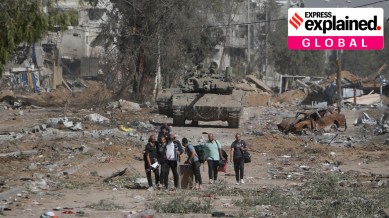‘Hell on Earth’: What is the humanitarian situation in Gaza?
A temporary pause in hostilities is set to bring much-needed relief to besieged Gazans. But the humanitarian situation in the battered enclave remains dired.

A four-day humanitarian pause to the conflict in Gaza began Friday (November 24).
With the fighting halted, aid agencies are hoping to use the pause to ramp up aid deliveries into the besieged enclave where shortages of food, fuel, drinking water and medicines have only worsened in recent weeks.
United Nations agencies have warned of mass disease outbreaks that could cause death rates to surge in Gaza. With parts of its northern half cut off from outside help for weeks, one UN spokesperson described it as a “hell on earth”.
What exactly is the humanitarian situation like in Gaza? We explain.
Displacement
Over 1.7 million people of Gaza’s population of 2.3 million are estimated to be internally displaced. Of them, about 1 million are staying in at least 156 shelters run by the UN Palestinian refugee agency (UNRWA), according to the UN’s Office for the Coordination of Humanitarian Affairs (OCHA).
Shelters are overcrowded and at more than four times capacity, with tens of thousands of civilians having fled south to escape the bulk of Israeli bombardments in recent days. However, the south has also been hammered by Israeli air strikes that have killed and injured non-combatants.
Most displaced men and older boys are sleeping in the open, next to the external walls of the shelters. Some families have pitched tents outside a shelter in Khan Younis, OCHA said.
Hospitals
None of the hospitals in northern Gaza are functioning normally due to bombardments and lack of fuel. OCHA says that only eight of 11 facilities in the south are functional and only one of them can perform complex surgery, according to the World Health Organization (WHO).
The WHO says it has been asked to help evacuate three northern hospitals and plans are underway. The number of premature births has risen by almost a third in Israeli-besieged Gaza over the past month as mothers suffer growing stress and trauma, according to Oxfam.
Aid delveries
The Rafah crossing reopened for limited aid supplies on October 21, but all other crossings into Gaza remain shut.
A total of 80 trucks carrying humanitarian supplies entered from Egypt on November 23. Egypt has said 130,000 litres of diesel and four trucks of gas will be delivered daily to Gaza when the truce starts, and that 200 trucks of aid would enter Gaza daily.
Water
Fresh fuel deliveries in recent days has allowed some water wells and pumping stations to resume operations in southern Gaza. However, there are grave concerns of dehydration in the north where the water desalination plant and the Israeli pipeline supplying water to the north are not functioning, according to OCHA.
Wastewater treatment plants are not operating at full capacity due to damage and fuel shortages and sewage has flowed in the streets near Rafah in recent days, OCHA says.
Fuel
Israel has been allowing a limited daily amount of fuel to enter Gaza from Egypt, with 75,000 litres arriving on Nov. 23.
Fuel is being distributed by UNRWA to support food distribution, and the operation of generators at hospitals, water and sanitation facilities, shelters, and other critical services.
(With inputs from Reuters)